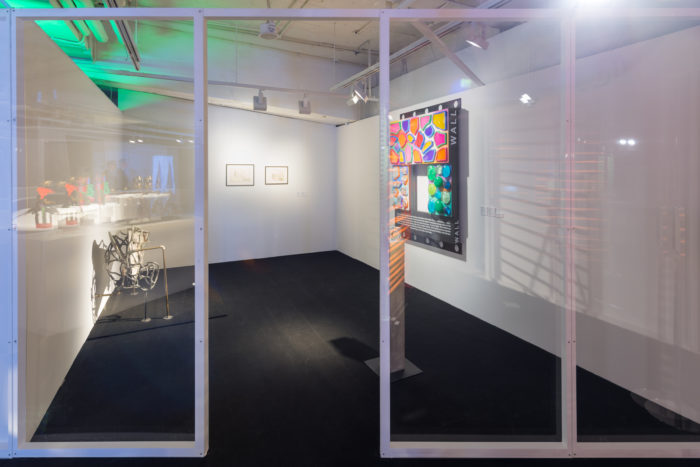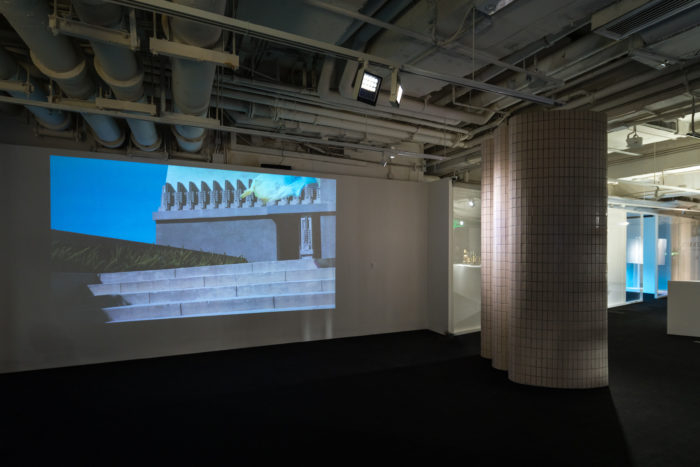
"Emerald City" is K11 Art Foundation’s first exhibition produced solely by KAF. The foundation, an offshoot of the K11 Art Malls founded by Adrian Cheng, is known for past collaborations with MoMA PS1 and Palais de Tokyo. But here, in their first independent exhibition curated by new director Venus Lau, geometry is at the center of the conversation.
I sat with Venus in a small, dark room lit only by a screen displaying the playable “Autosave: Redoubt,” created for the exhibition by Peter Nelson, Alexis Mailles, and Andrew Luk. Images of the bunker network along the Gin Drinkers’ Line, a British military defensive system used against the Japanese in the Battle of Hong Kong were meticulously coded by the artists onto the servers of popular online game Counter-Strike: Global Offensive. A phantom player ran through the labyrinth of tunnels as we spoke.
The show title’s purpose is twofold. “Gems,” says Lau, “The geometry of the gem, the way that light passes through a gem. This space had to be divided, cut like a gem to make the show work,” she went on, referring to the lower level of the Cosco Tower where the pop-up is hosted. It also refers to the Emerald City in The Wonderful Wizard of Oz from 1900. “Geometry is the blinding light of reason, of logic, and in the original Wizard of Oz, Emerald City was not green. It was a shining utopia of blinding light. It was so bright that you had to wear emerald colored glasses to enter.”

Lau’s research is extensive and spans from the birth of Euclid’s Elements to its arrival and translation in China during the Ming Dynasty, to the discovery of the amplituhedron—an immaterial geometric shape resembling a multi-dimensional and multi-faceted gem— as recently as 2013. The exhibition does not feature any blatantly geometric artworks, not in the vein of Albers or Stella. Lau says this is on purpose. “In order to show the ubiquity of geometry, I avoided including any artworks where geometry is the subject. The paintings, they are rectangles, the pedestals, the walls, it’s everywhere. The Euclidian geometry is the universal knowledge, there is no need for translation. We talk about globalization and the world as a space, but no one talks about geometry, which is the most pervasive. How can we think about space, and shared space in a different way?”
The show’s subterranean space is shared by 26 artists, young and old, local and not. Upon entering, we are met with Stall Bars created by Nik Kosmas and named after the 19th century playground equipment they imitate. The horizontal challenge suggested by the two floor to ceiling sculptures begging to be climbed outlines the subtle asymmetries of the human body, and thus, the asymmetries of social structures. Beyond these are several works by Carl Cheng, whose works in the 60s and 70s sought to create ecosystems within the confines of boxes in portable sizes. Cheng’s microwave-sized Erosion Machine mimics nature by allowing the viewer to witness the erosion process of sedimentary rocks enclosed in a box in the scale of handy domestic appliances. To the right, Neo-geo artist Ashley Bickerton’s Wall-Wall (The Black Mud Bubble...), displays artificial stones over colorful patterns that resemble out-of-focus pictures of a beach.

Ahead, Clarissa Tossin’s video, Ch’u Mayaa Ch’u Mayaa (2017), responds to the overlooked influence of Mayan architecture on Frank Lloyd Wright’s famous Hollyhock House in Los Angeles by re-appropriating the modernist architecture as a temple, and imbuing it with a dance performance based on gestures and postures on Mayan pottery and murals.
The final room is shared by Oscar Chan Yik Long’s Since All is Void, a corner installation modeled after the bathroom tiles in his childhood home, Alice Wang’s Untitled group of 300-million-year-old crinoid fossils gilded in 24K gold, and Ajay Kurian’s Tall Toys, No Noise (Fear), inspired by the emotion-cum-character in Pixar’s Inside Out. I told Venus that I felt this room was the most powerful, the most emotional. She joked that it wasn’t more emotional than the rest of the show: “You’re just sad that it’s the end.”
The whole of this exhibition presents a breakdown of geometry’s standard rules as a metaphor for dealing with difference. Geometry is here presented as something that can bring people together, and furthermore, seeks to connect Hong Kong’s art world with its general public. This goal is shared both by Lau and by K11’s founder, who has been planting art into spaces frequented by China’s general public since 2008.
Adrian Cheng, a young multi-hyphenate who has recently added furniture designer to his list of titles after a collaboration with the late Japanese master designer Shigeru Uchida, speaks to the spirit of "Emerald City" as a metaphor for the foundation’s mission. “Art should be accessible, people grow with art,” he says, “people are naturally creative but as we grow older, we forget that.” Speaking about China specifically, Cheng noted that fewer people frequent galleries and museums: “It isn’t part of the habit, and there weren’t always galleries or institutions for the public to visit.” The absence of public art space inspired him to merge museum programming with the most heavily patronized spaces in China: shopping malls. K11 Art Malls were born, expanded to multiple locations in China, and have grown to include an artists’ residency program, the “K11 Art Village,” in Wuhan, and since 2010, the K11 Art Foundation. KAF works hand-in-hand with K11 to support Chinese artists through residencies and exhibitions— the foundation curates the content, and the K11 brand brings it to the masses. Of the still growing project that will soon include a cultural academy for children. “It’s a journey of the imagination," Cheng says. "You don’t need to know everything about the art or art history, I want people to discover, to learn. Life is about learning and discovering.”



